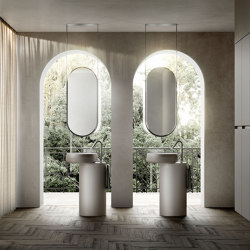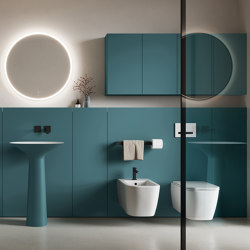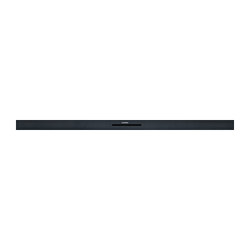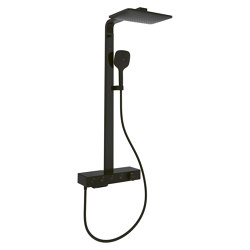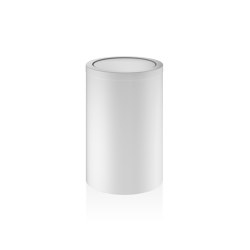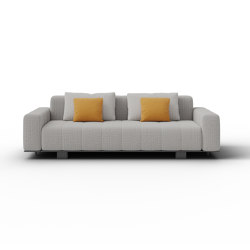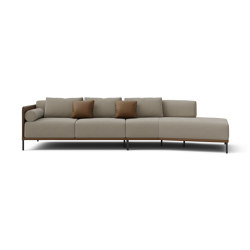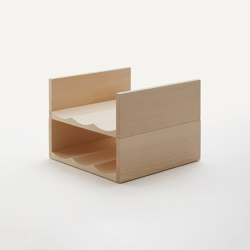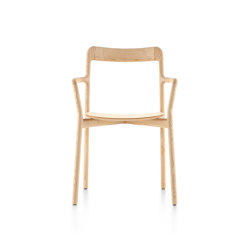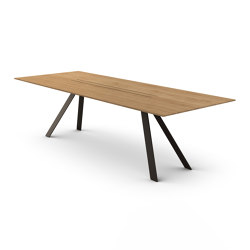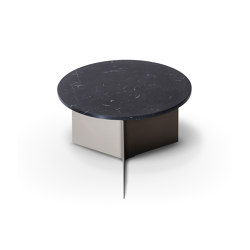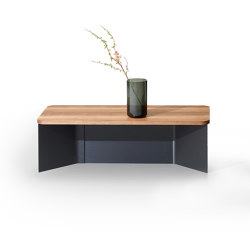About Boffi
MORE ABOUT BOFFI
In the world of contemporary interiors, Boffi's name is synonymous with innovation and excellence in kitchens and bathrooms. In 2010 company turned its attention and innovative approach on wardrobe sector as well.
An established international industry market leader in product innovation, communication strategy and in-store concept, Boffi is the only kitchen manufacturer to be awarded the “Compasso d’oro alla carriera” which it received in 1995.
From its earliest beginnings, Boffi identified creativity, production and entrepreneurship as its core strategic principles, and integrated them into all production decisions and operating processes.
These company policies were defined in the 1950's by the Boffi brothers, Dino, Paolo and Pier Ugo, as they developed their father (Piero’s) concepts and combined the company’s creativity with advanced production and technology.
At this time Dino, who was the ‘face’ of the company and one of the leaders in new Italian design, began to collaborate with expert modernist designers, such as Asti, Favre and Casé, who designed the revolutionary Series C and T12 kitchens. Other significant milestones in Boffi’s history included the appointment of Luigi Massoni as art director and the collaborations with Joe Colombo, Confalonieri’s graphics, the Ottagono magazine and the company club experience, Mobilia.
In the late 1980’s Boffi entered a new phase as Piero Lissoni and Roberto Gavazzi joined Paolo Boffi in the management of the company. From this point on the collaboration between the business, its production model and design creativity became even closer. Boffi achieved significant milestones, including the introduction of its bathroom brand; the opening of Boffi flagship stores in major cities all over the world; large-scale product presentations in dedicated exhibition spaces during the Milan Furniture Fair, and the acquisition of Norbert Wangen, a top quality German kitchen company.
In 2010 Boffi extended its activities further in to storage systems. Solferino, an innovative third generation wardrobe, with patented technologies, was launched. This is followed by the introduction of Saint Germain, a more traditional style product which, together with the kitchen and bathroom collections, creates a complete furniture system.
In the same year Boffi presented Aboutwater; a new brand, presenting a range of taps. This collaboration with faucet manufacturer Fantini, combines Boffi’s creativity and Fantini’s technological know-how and utilises the international distribution network of both companies.
In 2010 Boffi also successfully completed the ISO 14001 certification process. This important step was natural for a company where the culture of sustainability has, throughout its history, always been relevant. As a core player in the history of Italian design, sustainability is part of Boffi’s values, culture, creative technology and entrepreneurship, and is at the heart of every decision, phase of planning, production and control.
Boffi History – A Timeline
1934 Piero Boffi leaves Caproni and founds his own craftsman-led company.
1947 Boffi builds the first factory. His sons Dino, Pier Ugo and Paolo enter the company.
1950-1965 Giulio Confalonieri is appointed Boffi's graphic designer.
1954 The first coloured kitchen, The Series C is designed by Asti, Favre and Boffi,
1960-1980 Luigi Massoni is appointed Art Director, and designs, amongst others, his most famous kitchens Xila and Dogu.
1960 T12 by Gian Casé and Pier Ugo Boffi is designed, the first kitchen matching wood and laminate.
1963 Minikitchen by Joe Colombo, is exhibited at the Triennale and MoMA.
1980 Boffi enters the bathroom sector. Antonio Citterio designs Factory, a synthesis between storage and high tech.
1989 Roberto Gavazzi enters the company and is appointed Managing Director.
1990 Piero Lissoni is appointed Art Director and designs the Esprit and Latina.
1995 Compasso d’oro alla carriera. Studio Paris is opened, the first international Boffi store outside Italy.
1996 The company is awarded the ISO 9001.
1997 WK6 (World Kitchen 6) is presented at San Paolo Converso church in Milan.
1998 The introduction of two historic bathrooms collections - I fiumi by Claudio Silvestrin and Minimal by Giulio Gianturco - grows the bathroom business.
1998 Boffi Solferino, the first mono-brand Boffi store dedicated to the bathroom opens in Milan. In 2003 it becomes the company flagship store encompassing kitchens, bathrooms and, in 2010, wardrobes.
2000 The opening of Boffi Soho, the first dedicated Boffi store in the United States
2001 Boffi becomes a member of Fondazione Altagamma, an association of luxury Italian design companies who enjoy an international reputation; the aim of the Foundation is to promote its member brands, Italian style and culture worldwide.
2002 The company obtains the extension to ISO 9001:2000; LT kitchen (design Piero Lissoni) is presented in Milan at Ex-Officine Caproni.
2003 Acquisition of Norbert Wangen, a top quality kitchen brand. Norbert Wangen designs several kitchen and bathroom products. Case System 2.3 (design Piero Lissoni) wins the “Red Dot” Award for the best product design.
2004 Cut taps (design Mario Tessarollo and Tiberio Cerato) is selected for Compasso d’Oro and wins the “Red Dot” Award as best design product.
2006 A new system collection is launched, the Anthea wall division is the first of a new range of systems designed to rationalise space. Naoto Fukasawa begins a collaboration with Boffi, designing the Terra bathtub.
2007 Table System kitchen (design Piero Lissoni) wins the 2007 Chicago Atheneum Good Design Award.
2008 The Duemilaotto kitchen (by Piero Lissoni) and the Sabbia bath system – washbasins and bathtub - (by Naoto Fukasawa) are showcased at the Magazzini di Porta Genova. The +/- cabinet is awarded the Good Design Award of the Chicago Athenaeum.
2010 Boffi enriches the range of products with “Solferino”, a wardrobe System. There are 21 international direct mono-brand shops, managed by Boffi Trade; 48 indirect ones. Solferino showroom is enlarged and a new space called “L’appartamento” is presented. Aboutwater project in collaboration with Fantini. Boffi successfully completes the ISO 14001 certification process.
2011 Aprile kitchen, design Piero Lissoni, is the winner in the Kitchen category of EDIDA (ELLE DECORATION INTERNATIONAL DESIGN AWARD) 2010/2011. Launch of a new wardrobe: Saint Germain. The international direct mono-brand showrooms become 23.
2012 In February a new Training Centre, a space dedicated to Boffi dealers for the training courses and to architects’ visits as well, is inaugurated at Boffi headquarters.
2014 Boffi celebrates 80 year history presenting the first outdoor kitchen, Open (design Piero Lissoni) and the first kitchen designed by a woman, Salinas (design Patricia Urquiola).
2015 Boffi and De Padova reach a merging agreement for the two companies.
Figures
3 production departments: kitchens, bathrooms and systems
187 Boffi spa employees and 104 Boffi Trade employees
25 thousand square meters covered by the company production
64 million euro consolidated turnover (Boffi spa and Boffi Trade)
81% of the consolidated turnover generated by international markets outside Italy
19% of the consolidated turnover generated in Italy
71% of the turnover from the kitchen department
24% of the turnover from the bathroom department
5 % of the turnover from the systems department
21 direct Boffi stores
40 indirect mono-brand Boffi stores
183 retailers in Italy
100 retailers internationally outside Italy
AUSTRALIA, AUSTRIA, BELGIUM, BULGARIA, CANADA, CHINA, CYPRUS, COSTARICA, CROATIA, CZECH REPUBLIC, DENMARK, ESTONIA, FRANCE, GEORGIA, GERMANY, GREECE, HOLLAND, HONG KONG, INDIA, INDONESIA, ISLAND, ISRAEL, ITALY, JAPAN, JORDAN, KOREA, LATVIA, LEBANON, LITHUANIAN, LUXEMBOURG, MACEDONIA, MALAYSIA, MALTA, MEXICO, NORWAY, NEW ZEALAND, OMAN, PHIILIPPINES, PORTUGAL, PUERTO RICO, REPUBLIC OF KOSOVO, RUSSIA, SINGAPORE, SLOVENIA, SPAIN, SWEDEN, SWITZERLAND, THAILAND, TAIWAN, TURKEY, UAE, UNITED STATES, UK, VENEZUELA.
Production
Boffi combines the most modern production processes together with traditional hand-made craft techniques. Utilising this approach Boffi maintains its tradition and enhances its product quality.
Boffi’s high quality is the result of controlled production schedules (based on numeric control and lean enterprise) which is combined with the company’s custom-made tradition.
Boffi utilises and evolves techniques such as bright lacquer painting, with hand tooling, enhancing quality and finish.
Boffi has also established a collaborative network to enhance its production, working with some of the best companies in sectors outside its own core competencies as producers of electrical appliances, steel, stone, sanitary ware and taps. The alliances allow Boffi to evolve the best technological solutions in partnership with its external suppliers and to offer a complete range of the most sophisticated and best products.
Design
Boffi has appointed three art directors since it’s inception: Luigi Massoni, Antonio Citterio and Piero Lissoni. These three famous designers did not simply design a series of projects, but encouraged collaborations with many other designers, enhancing and developing the product catalogue. Their focus was not only on The design of individual products, but on developing entire collections that embody an easily identifiable style appealing to Boffi’s high-quality focused target market.
Designers that have collaborated with Boffi include : Romano Adolini, Alessandro Andreucci+Christian Hoisl, Monica Armani, Dror Benshetrit, Jeffrey Bernett, Stephen Burks, Victor Carrasco,Tiberio Cerato, Antonio Citterio, Mårten Claesson- Eero Koivisto- Ola Rune, Joe Colombo, Alberto Colonello, Decoma Design, Felicia Ferrone, Naoto Fukasawa, Maurizio Galante & Tal Lancman, Giulio Gianturco, Johanna Grawunder, Davide Groppi, Peter Jamieson, Beat Karrer, Gianluigi Landoni, Piero Lissoni, Luigi Massoni, Paolo Nava, Nendo, neunzig° design, Ludovica e Roberto Palomba, Kensaku Oshiro, Marc Sadler, Martin Schmitz, Claudio Silvestrin, Soap Atelier, Studiocharlie, Studio Kairos, design Tanzi, Mario Tessarollo, Wolfgang Tolk, David Trubridge, Patricia Urquiola, Victor Vasilev, Marcel Wanders, Norbert Wangen.
Market approach
Boffi has always implemented an integrated market strategy that celebrates the company’s partnerships with its designers, while promoting Boffi’s production excellence.
Boffi's innovation, always leading and setting new standards of design style and excellence, is demonstrated throughout in every activity in the company. Including the elements that communicate the company and its products to the world.
In the 1950’s, Giulio Confalonieri created Boffi's corporate identity. This rigorous and innovative design, novel and fresh, not only represented the most exacting design standards which allowed the company to stand out in the furnishing industry, it also had an enduring appeal and longevity. Like so many of Boffi's products, it looks as contemporary and relevant today, as the day it was designed - the true embodiment and visual representation of Boffi's philosophy.
Boffi began utilising events and unique catalogues as a way of introducing products and announce a consolidated company policy that was aimed at new production and commercial partnerships with top quality sector brands. This strategy was further developed in the 1990’s after Roberto Gavazzi and Piero Lissoni joined the company.
Boffi was the first company to exhibit its production at the Milan Furnishing Exhibition as well as in ‘unusual’ spaces such as factories and the San Paolo Converso church. These fresh and innovative marketing initiatives created a trend and turned an important exhibition into a truly cultural event.
In 1998, Boffi opened the first mono-brand store, Bathroom – Boffi Solferino, in via Solferino in Milan – which not only identified the new production line, but started a new distribution policy which led to the opening of mono-brand stores; the milestones in the company’s expansion policy.
In 2007 the trend towards commercial partnerships spurred Boffi to collaborate with Porro and Living Divani, to open new concept showrooms, simply called By, which exhibited a complete domestic landscape aimed at a cosmopolitan public.
In 2010 Boffi collaborated with Fantini, a leader in the bathroom industry; introducing Aboutwater, the aim is to introduce taps collections, characterized by elegance and modern design, excellent projects, accurately produced, and finally distributed through the commercial network of both companies, enlarging the market beyond the respective sectors.
Aboutwater is an ideal collection for the contract sector, enabling a great production capacity for large orders, as well as refined design and excellent technology.
Boffi mono-brand stores
Since 1994, the year of first flagship store opening in Milan in Corso Monforte, Boffi has had an active expansion strategy becoming the most representative Italian kitchen company on the international markets, with about 60 mono-brand stores, of which there are 21 direct stores in circa 60 countries.
America: Chicago, Mexico City, Los Angeles, Miami, New York, San Francisco, Washington.
Asia: Bangkok, Hong Kong, Kuala Lumpur, Jakarta, Manila, New Delhi, Seoul, Singapore, Taipei
Australia: Sydney
Canada: Montreal
Europe: Antwerp, Aarau, Amsterdam, Barcelona, Berlin, Cannes, Cologne, Copenhagen, Frankfurt, Hamburg, Konstanz, London, Lausanne, Lucerne, Lyon, Matzingen, Moscow, Munich, Oslo, Palma de Mallorca, Paris, Palencia, Porto, Rotterdam, Strassen, Valencia, Zurich.
Italy: Latina, Milan, Prato, Rome, Treviso, Venice.
Middle East: Amman, Tel Aviv.
New Zealand: Auckland
In the world of contemporary interiors, Boffi's name is synonymous with innovation and excellence in kitchens and bathrooms. In 2010 company turned its attention and innovative approach on wardrobe sector as well.
An established international industry market leader in product innovation, communication strategy and in-store concept, Boffi is the only kitchen manufacturer to be awarded the “Compasso d’oro alla carriera” which it received in 1995.
From its earliest beginnings, Boffi identified creativity, production and entrepreneurship as its core strategic principles, and integrated them into all production decisions and operating processes.
These company policies were defined in the 1950's by the Boffi brothers, Dino, Paolo and Pier Ugo, as they developed their father (Piero’s) concepts and combined the company’s creativity with advanced production and technology.
At this time Dino, who was the ‘face’ of the company and one of the leaders in new Italian design, began to collaborate with expert modernist designers, such as Asti, Favre and Casé, who designed the revolutionary Series C and T12 kitchens. Other significant milestones in Boffi’s history included the appointment of Luigi Massoni as art director and the collaborations with Joe Colombo, Confalonieri’s graphics, the Ottagono magazine and the company club experience, Mobilia.
In the late 1980’s Boffi entered a new phase as Piero Lissoni and Roberto Gavazzi joined Paolo Boffi in the management of the company. From this point on the collaboration between the business, its production model and design creativity became even closer. Boffi achieved significant milestones, including the introduction of its bathroom brand; the opening of Boffi flagship stores in major cities all over the world; large-scale product presentations in dedicated exhibition spaces during the Milan Furniture Fair, and the acquisition of Norbert Wangen, a top quality German kitchen company.
In 2010 Boffi extended its activities further in to storage systems. Solferino, an innovative third generation wardrobe, with patented technologies, was launched. This is followed by the introduction of Saint Germain, a more traditional style product which, together with the kitchen and bathroom collections, creates a complete furniture system.
In the same year Boffi presented Aboutwater; a new brand, presenting a range of taps. This collaboration with faucet manufacturer Fantini, combines Boffi’s creativity and Fantini’s technological know-how and utilises the international distribution network of both companies.
In 2010 Boffi also successfully completed the ISO 14001 certification process. This important step was natural for a company where the culture of sustainability has, throughout its history, always been relevant. As a core player in the history of Italian design, sustainability is part of Boffi’s values, culture, creative technology and entrepreneurship, and is at the heart of every decision, phase of planning, production and control.
Boffi History – A Timeline
1934 Piero Boffi leaves Caproni and founds his own craftsman-led company.
1947 Boffi builds the first factory. His sons Dino, Pier Ugo and Paolo enter the company.
1950-1965 Giulio Confalonieri is appointed Boffi's graphic designer.
1954 The first coloured kitchen, The Series C is designed by Asti, Favre and Boffi,
1960-1980 Luigi Massoni is appointed Art Director, and designs, amongst others, his most famous kitchens Xila and Dogu.
1960 T12 by Gian Casé and Pier Ugo Boffi is designed, the first kitchen matching wood and laminate.
1963 Minikitchen by Joe Colombo, is exhibited at the Triennale and MoMA.
1980 Boffi enters the bathroom sector. Antonio Citterio designs Factory, a synthesis between storage and high tech.
1989 Roberto Gavazzi enters the company and is appointed Managing Director.
1990 Piero Lissoni is appointed Art Director and designs the Esprit and Latina.
1995 Compasso d’oro alla carriera. Studio Paris is opened, the first international Boffi store outside Italy.
1996 The company is awarded the ISO 9001.
1997 WK6 (World Kitchen 6) is presented at San Paolo Converso church in Milan.
1998 The introduction of two historic bathrooms collections - I fiumi by Claudio Silvestrin and Minimal by Giulio Gianturco - grows the bathroom business.
1998 Boffi Solferino, the first mono-brand Boffi store dedicated to the bathroom opens in Milan. In 2003 it becomes the company flagship store encompassing kitchens, bathrooms and, in 2010, wardrobes.
2000 The opening of Boffi Soho, the first dedicated Boffi store in the United States
2001 Boffi becomes a member of Fondazione Altagamma, an association of luxury Italian design companies who enjoy an international reputation; the aim of the Foundation is to promote its member brands, Italian style and culture worldwide.
2002 The company obtains the extension to ISO 9001:2000; LT kitchen (design Piero Lissoni) is presented in Milan at Ex-Officine Caproni.
2003 Acquisition of Norbert Wangen, a top quality kitchen brand. Norbert Wangen designs several kitchen and bathroom products. Case System 2.3 (design Piero Lissoni) wins the “Red Dot” Award for the best product design.
2004 Cut taps (design Mario Tessarollo and Tiberio Cerato) is selected for Compasso d’Oro and wins the “Red Dot” Award as best design product.
2006 A new system collection is launched, the Anthea wall division is the first of a new range of systems designed to rationalise space. Naoto Fukasawa begins a collaboration with Boffi, designing the Terra bathtub.
2007 Table System kitchen (design Piero Lissoni) wins the 2007 Chicago Atheneum Good Design Award.
2008 The Duemilaotto kitchen (by Piero Lissoni) and the Sabbia bath system – washbasins and bathtub - (by Naoto Fukasawa) are showcased at the Magazzini di Porta Genova. The +/- cabinet is awarded the Good Design Award of the Chicago Athenaeum.
2010 Boffi enriches the range of products with “Solferino”, a wardrobe System. There are 21 international direct mono-brand shops, managed by Boffi Trade; 48 indirect ones. Solferino showroom is enlarged and a new space called “L’appartamento” is presented. Aboutwater project in collaboration with Fantini. Boffi successfully completes the ISO 14001 certification process.
2011 Aprile kitchen, design Piero Lissoni, is the winner in the Kitchen category of EDIDA (ELLE DECORATION INTERNATIONAL DESIGN AWARD) 2010/2011. Launch of a new wardrobe: Saint Germain. The international direct mono-brand showrooms become 23.
2012 In February a new Training Centre, a space dedicated to Boffi dealers for the training courses and to architects’ visits as well, is inaugurated at Boffi headquarters.
2014 Boffi celebrates 80 year history presenting the first outdoor kitchen, Open (design Piero Lissoni) and the first kitchen designed by a woman, Salinas (design Patricia Urquiola).
2015 Boffi and De Padova reach a merging agreement for the two companies.
Figures
3 production departments: kitchens, bathrooms and systems
187 Boffi spa employees and 104 Boffi Trade employees
25 thousand square meters covered by the company production
64 million euro consolidated turnover (Boffi spa and Boffi Trade)
81% of the consolidated turnover generated by international markets outside Italy
19% of the consolidated turnover generated in Italy
71% of the turnover from the kitchen department
24% of the turnover from the bathroom department
5 % of the turnover from the systems department
21 direct Boffi stores
40 indirect mono-brand Boffi stores
183 retailers in Italy
100 retailers internationally outside Italy
AUSTRALIA, AUSTRIA, BELGIUM, BULGARIA, CANADA, CHINA, CYPRUS, COSTARICA, CROATIA, CZECH REPUBLIC, DENMARK, ESTONIA, FRANCE, GEORGIA, GERMANY, GREECE, HOLLAND, HONG KONG, INDIA, INDONESIA, ISLAND, ISRAEL, ITALY, JAPAN, JORDAN, KOREA, LATVIA, LEBANON, LITHUANIAN, LUXEMBOURG, MACEDONIA, MALAYSIA, MALTA, MEXICO, NORWAY, NEW ZEALAND, OMAN, PHIILIPPINES, PORTUGAL, PUERTO RICO, REPUBLIC OF KOSOVO, RUSSIA, SINGAPORE, SLOVENIA, SPAIN, SWEDEN, SWITZERLAND, THAILAND, TAIWAN, TURKEY, UAE, UNITED STATES, UK, VENEZUELA.
Production
Boffi combines the most modern production processes together with traditional hand-made craft techniques. Utilising this approach Boffi maintains its tradition and enhances its product quality.
Boffi’s high quality is the result of controlled production schedules (based on numeric control and lean enterprise) which is combined with the company’s custom-made tradition.
Boffi utilises and evolves techniques such as bright lacquer painting, with hand tooling, enhancing quality and finish.
Boffi has also established a collaborative network to enhance its production, working with some of the best companies in sectors outside its own core competencies as producers of electrical appliances, steel, stone, sanitary ware and taps. The alliances allow Boffi to evolve the best technological solutions in partnership with its external suppliers and to offer a complete range of the most sophisticated and best products.
Design
Boffi has appointed three art directors since it’s inception: Luigi Massoni, Antonio Citterio and Piero Lissoni. These three famous designers did not simply design a series of projects, but encouraged collaborations with many other designers, enhancing and developing the product catalogue. Their focus was not only on The design of individual products, but on developing entire collections that embody an easily identifiable style appealing to Boffi’s high-quality focused target market.
Designers that have collaborated with Boffi include : Romano Adolini, Alessandro Andreucci+Christian Hoisl, Monica Armani, Dror Benshetrit, Jeffrey Bernett, Stephen Burks, Victor Carrasco,Tiberio Cerato, Antonio Citterio, Mårten Claesson- Eero Koivisto- Ola Rune, Joe Colombo, Alberto Colonello, Decoma Design, Felicia Ferrone, Naoto Fukasawa, Maurizio Galante & Tal Lancman, Giulio Gianturco, Johanna Grawunder, Davide Groppi, Peter Jamieson, Beat Karrer, Gianluigi Landoni, Piero Lissoni, Luigi Massoni, Paolo Nava, Nendo, neunzig° design, Ludovica e Roberto Palomba, Kensaku Oshiro, Marc Sadler, Martin Schmitz, Claudio Silvestrin, Soap Atelier, Studiocharlie, Studio Kairos, design Tanzi, Mario Tessarollo, Wolfgang Tolk, David Trubridge, Patricia Urquiola, Victor Vasilev, Marcel Wanders, Norbert Wangen.
Market approach
Boffi has always implemented an integrated market strategy that celebrates the company’s partnerships with its designers, while promoting Boffi’s production excellence.
Boffi's innovation, always leading and setting new standards of design style and excellence, is demonstrated throughout in every activity in the company. Including the elements that communicate the company and its products to the world.
In the 1950’s, Giulio Confalonieri created Boffi's corporate identity. This rigorous and innovative design, novel and fresh, not only represented the most exacting design standards which allowed the company to stand out in the furnishing industry, it also had an enduring appeal and longevity. Like so many of Boffi's products, it looks as contemporary and relevant today, as the day it was designed - the true embodiment and visual representation of Boffi's philosophy.
Boffi began utilising events and unique catalogues as a way of introducing products and announce a consolidated company policy that was aimed at new production and commercial partnerships with top quality sector brands. This strategy was further developed in the 1990’s after Roberto Gavazzi and Piero Lissoni joined the company.
Boffi was the first company to exhibit its production at the Milan Furnishing Exhibition as well as in ‘unusual’ spaces such as factories and the San Paolo Converso church. These fresh and innovative marketing initiatives created a trend and turned an important exhibition into a truly cultural event.
In 1998, Boffi opened the first mono-brand store, Bathroom – Boffi Solferino, in via Solferino in Milan – which not only identified the new production line, but started a new distribution policy which led to the opening of mono-brand stores; the milestones in the company’s expansion policy.
In 2007 the trend towards commercial partnerships spurred Boffi to collaborate with Porro and Living Divani, to open new concept showrooms, simply called By, which exhibited a complete domestic landscape aimed at a cosmopolitan public.
In 2010 Boffi collaborated with Fantini, a leader in the bathroom industry; introducing Aboutwater, the aim is to introduce taps collections, characterized by elegance and modern design, excellent projects, accurately produced, and finally distributed through the commercial network of both companies, enlarging the market beyond the respective sectors.
Aboutwater is an ideal collection for the contract sector, enabling a great production capacity for large orders, as well as refined design and excellent technology.
Boffi mono-brand stores
Since 1994, the year of first flagship store opening in Milan in Corso Monforte, Boffi has had an active expansion strategy becoming the most representative Italian kitchen company on the international markets, with about 60 mono-brand stores, of which there are 21 direct stores in circa 60 countries.
America: Chicago, Mexico City, Los Angeles, Miami, New York, San Francisco, Washington.
Asia: Bangkok, Hong Kong, Kuala Lumpur, Jakarta, Manila, New Delhi, Seoul, Singapore, Taipei
Australia: Sydney
Canada: Montreal
Europe: Antwerp, Aarau, Amsterdam, Barcelona, Berlin, Cannes, Cologne, Copenhagen, Frankfurt, Hamburg, Konstanz, London, Lausanne, Lucerne, Lyon, Matzingen, Moscow, Munich, Oslo, Palma de Mallorca, Paris, Palencia, Porto, Rotterdam, Strassen, Valencia, Zurich.
Italy: Latina, Milan, Prato, Rome, Treviso, Venice.
Middle East: Amman, Tel Aviv.
New Zealand: Auckland
MORE ABOUT BOFFI


